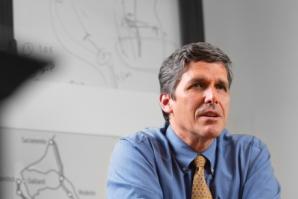For nearly a dozen years, through Republican and Democratic administrations, California has studied and debated the wisdom of constructing a high-speed rail system to link the state’s largest metropolitan areas. Last year, the state’s voters finally made a decision: They approved borrowing $9 billion to begin planning and building the nation’s first 220-mph train network with nearly another billion to improve connecting passenger trains.
That vote put California in the lead among the nation’s 11 federally designated high-speed rail corridors and first in line for a chunk of the $8 billion earmarked for such train systems in President Obama’s massive stimulus plan. The California High-Speed Rail Authority and state leaders are working to gain at least $2 billion from the fund since we have the nation’s only genuine, shovel-ready project.
The potential benefits of high-speed rail are huge. Transportation planners say a bullet train would meet or exceed the demand for transportation from our growing population between now and 2030 — at less than half the cost of building the five airport runways, 90 departure gates and 3,000 miles of new freeways that would otherwise be required. Building the system will provide 160,000 construction jobs and 450,000 permanent jobs in related industries, providing a much-needed boost to the economy.
Here in the Central Valley, where most of the state’s population growth is predicted to occur, we have much to gain. A bullet train could help us reduce congestion and pollution by getting commuters off the roads; it could encourage housing and retail development near train stations, thus avoiding the endless sprawl of our coastal cities.
The majority of Central Valley business leaders and chambers of commerce support it. To his credit, Sacramento’s new mayor Kevin Johnson has actively engaged the state rail authority to explore how the Sacramento rail system could be built sooner than the now-planned 2022 and to ensure that the city’s other transit plans (such as the new central station in the railyard development) dovetail with the overall system.
Critics cite risks such as the huge size and cost of the system. At $45 billion, it is even larger than the massive California Aqueduct and thus the largest public works project in the state’s history. However, taxpayers are well-protected: Each of the eight or nine corridors or segments must have full funding in place before construction can begin. Bond money can pay for no more than one-half the cost of each segment with the rest coming from federal funds and private partners.
Right now the rail authority is holding public meetings to identify the issues each region wants addressed in its proposed corridor. Now is the time to express legitimate concerns about the how and where of high-speed rail in the 800-mile route that will link San Francisco, Sacramento and the Central Valley with Southern California.
But now is not the time to naysay and undercut this bold effort to invest in the future of our state and our country. California has led the nation many times before; we must lead it again now.
Recommended For You
Getting on the Right Track
High-speed rail will reap benefits in the long term
High-speed trains linking Northern and Southern California have been a point of contention for more than a decade. For some, such “bullet trains” are the ideal solution to growing transportation needs; for others, they represent a boondoggle with enormous economic risk.

The Conductor
The California High-Speed Rail Authority replaced an engineer with a political operative to lead the nation’s biggest public works project. Jeff Morales instantly charmed his opponents but made technical decisions that placed high-speed rail at the mercy of the courts. Can Morales save his runaway train?


